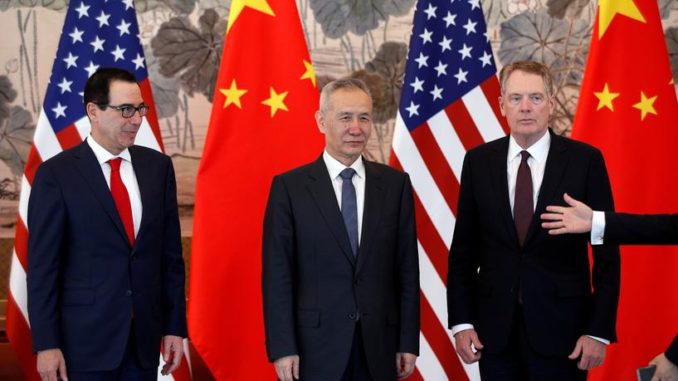
Chinese Vice Premier Liu He will visit the United States this week for trade talks, Beijing said on Tuesday, playing down a sudden increase in tension after U.S. President Donald Trump vowed to impose new tariffs.
U.S. officials have said China has backtracked on substantial commitments made during months of negotiations seeking to end their bruising trade war.
Those concerns prompted Trump to say on Sunday that he would raise tariffs on $200 billion worth of Chinese goods to 25 percent from 10 percent by the end of the week, and would “soon” target remaining Chinese imports with tariffs.
Trump’s tweets abruptly ended a five-month ceasefire in a trade dispute that has cost the two countries billions of dollars and disrupted manufacturing supply chains.
Fears that negotiations were unraveling drove global stocks and oil prices lower on Monday, and fed speculation that China could cancel Liu’s planned visit.
China’s Commerce Ministry confirmed that Liu, who leads the talks for Beijing, will visit the United States on Thursday and Friday. The ministry did not elaborate or give the expected topics of discussion.
Beijing’s response to the prospect of new tariffs has been reserved, and on Tuesday, Foreign Ministry spokesman Geng Shuang told a news briefing that mutual respect was the basis for reaching a trade agreement.
“Adding tariffs can’t resolve any problem,” Geng said.
“Talks are by their nature a process of discussion. It’s normal for both sides to have differences. China won’t shun problems and is sincere about continuing talks,” he said.
“We hope the U.S. side can work hard with China, to meet each other halfway, and on the basis of mutual respect and equality, resolve each other’s reasonable concerns, and strive for a mutually beneficial, win-win agreement.”
Beijing’s willingness to continue with the talks in the face of Trump’s tweets shows it would remain calm and “focus on the talks rather than engage in public opinion warfare”, the widely-read state-run Global Times tabloid said in an editorial.
In a commentary, the paper’s parent, the ruling Communist Party’s official People’s Daily, said China had weathered such threats from the United States before, and would keep calm.
“China has complete confidence to face all possible difficulties and challenges in the China-U.S. economic and trade consultation process, which is why China has always been able to maintain its composure,” it said on its app.
If Liu joins the delegation to Washington, “it will signal how serious China is and indicates that China and the U.S. are going to talk further,” economists at ING said in a note on Tuesday.
ADVERTISEMENT
‘EROSION OF COMMITMENTS’
U.S. Trade Representative Robert Lighthizer, who has been an advocate for tough structural changes in China, said on Monday that Beijing had reneged on previous commitments that would have changed the pact substantially.
“Over the course of the last week or so we have seen … an erosion in commitments by China,” Lighthizer told reporters. “That, in our view, is unacceptable.”
“We’re not breaking off talks at this point. But for now … come Friday there will be tariffs in place.
Treasury Secretary Steven Mnuchin, considered to be less hawkish toward China, said its backtracking became clear with “new information” over the weekend.
He declined to give specifics and said the U.S. side had originally hoped to conclude a deal either way this week.
“They were trying to go back on language that had been previously negotiated, very clear language, that had the potential of changing the deal dramatically,” Mnuchin said.
“The entire economic team … are completely unified and recommended to the president to move forward with tariffs if we are not able to conclude a deal by the end of the week.”
China has repeatedly said it will make changes to open its economy on its own timeline, not in response to trade disputes.
But recently it has adopted new laws, including a Foreign Investment Law, and amended others, moves some see as efforts to tackle concerns of the United States and other foreign investors, including those from China’s largest trading partner, the European Union.
The United States now has 25 percent tariffs on $50 billion of Chinese machinery and technology goods, and 10 percent tariffs on $200 billion of products ranging from computer modems and routers to furniture, lighting and building materials.
Negotiations to remove U.S. tariffs have been one of the remaining sticking points. China wants the tariffs removed. U.S. officials want to keep some, if not all, as part of any final deal to ensure China lives up to its commitments.
Reporting by Beijing Monitoring Desk; Editing by Kim Coghill and Clarence FernandezOur Standards:The Thomson Reuters Trust Principles.
BY REUTERS
BEIJING/WASHINGTON (Reuters) –
